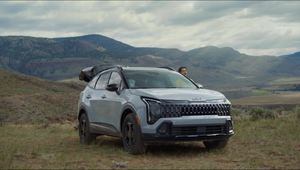
Uprising: Tucker Stosic Designs Your Favourite Band Tees

Tucker Stosic’s lifelong passion is skiing, specifically freestyle skiing, which involves jumps and rails and the like. In freestyle skiing, the goal is to essentially come up with the most creative run through a course but execute with tight, top-notch technical precision. Nowadays a senior art director at David&Goliath in Los Angeles, Tucker sees similarities between his passion and his job. “While I don’t have giant planks strapped to my feet or goggles on my face as an art director,” he says, “I’m still finding the most creative ways to approach problems, and ensuring the technical execution of those creative approaches is bar-none.”
Tucker grew up 20 minutes away from Tahoe, home of Lake Tahoe, which straddles the border of California and Nevada. At every opportunity he was either up a mountain or at the lake and “probably would have had a pretty sweet mountain beard” if he wasn’t a child. We’re rooting for him to grow one now.
In his words, he grew up in “a fairly normal family” - cute house, two parents, a sister and two dogs. It wasn’t a creative family either. His dad works in insurance and his mum is a ski instructor. “And I’m not just talking immediate family, I’m talking extended too,” he adds. “When I told them I was going to get a degree in advertising, the first thing I was told was, ‘That’s fine, just make sure that you’ll be able to make enough money to have a career’.” But that mindset has informed his career to this day and made him think of the industry that he works in differently. “I always think a lot more about whether or not what I’m producing is enjoyable to the average consumer, and not just made for creative or marketing people,” Tucker says. “Would my dad laugh at this ad as he’s watching TV after his nine-to-five? Would my sister tweet about this when she’s not writing her master’s thesis in psychology? It’s just an interesting lens that I inherently put on all of my work just as a gut check.”
Tucker went on to study at the University of Oregon but began life there as a computer science student before switching to human physiology and then graphic design before ending up in the journalism program with a focus on advertising. “U of O, and specifically the ad program, put me in a space where I could connect and collaborate with other ambitious creative people and I loved that,” he says. “I found the experience incredibly important for my career, not because of anything I learned in the program, but because I got to be around so many diverse ways of thinking, problem solving, and collaboration. It really broadened my creative horizons and is something I reach to for inspiration still.”
While studying, Tucker dipped his toe into the industry as an intern at Fallon in Minneapolis before hunting down a job for real later on. And we don’t use the word hunt lightly. He sent “exactly 108 emails” off to different creative directors around the US to see if any of their agencies had openings. He’s been at David&Goliath since September 2017, much of his advertising career.
A lesson he learned early on was to only pitch the work that he wanted to make. “And that was a tough lesson starting out,” Tucker says. “You want to build a book, and at that point you’re happy to get anything at all in it. And when you only pitch the work you want to make, it’s not always going to be what the client wants to make, or what your creative directors want to make. So, you do see teams going out and producing stuff because they brought the safer idea, and you’re stuck back at the office, which is tough.” But he came to realise that when going on production for a project he had no love for, he was much better off “swinging for the fences and missing than trying to bunt” just because that's what people wanted. “Let other teams take the bunts while you keep swinging big,” he says. “You’ll get some big hits eventually and that’s going to have so much more of an impact on your career than a bunch of bunts.”
Speaking of production, one of the first projects that Tucker was assigned was helping to comp storyboard frames for a creative director team’s TV assignment. He used the opportunity to pitch in ideas for the spots as well, and ended up writing the main insight and structure for the spot. As a result, he was sent to the production. “Going on production, I remember feeling so lost and just trying to pretend like I knew what I was doing,” Tucker says. “You come into the industry knowing roughly what you’re doing in the office, but you have absolutely no clue what you are doing on your first set. I also remember it being in the 40s and extremely windy in the middle of the desert. I’m still coughing up sand from that day, so it makes it hard to forget.”
A recent project has also proved to be a bit of a game-changer, something with the potential to transform his career. “What’s that smell? Is it the smell of a career being changed?” he jokes, introducing the project. The smell is in fact a face mask that smells of chicken. Created for fast food chain Jack in the Box, the Chicken-Scented Face Mask was launched to promote the brand’s Unchicken Sandwich, its first ever plant-based chicken sandwich and one of the first faux chicken sandwiches to hit the US fast food scene. “A pretty dumb idea needed an equally dumb intro, but the Chicken Scented Face Masks for Jack in the Box is the piece that I really feel is a career changer for me,” Tucker says. “This was a project full of big firsts; first time doing an earned media stunt, first time heading a project and leading our partner agencies, first time building a web experience, first time shooting long-form content. But at the end of the day, this project ended up being a massive hit, and generating a ton of buzz. In a lot of ways, it’s changed my career internally at David&Goliath, opening up opportunities with the client for more earned media work, and opportunities to take over more leadership on projects. I think it’s hopefully that piece that people will point to and go, ‘that’s the piece I wish I did’.”

Outside of work, Tucker has somewhat of a “side-hustle-turned-actual-business” on the go. He acts as a design studio for clientele in the music industry (and you can check out some of that work here), which he started in college, designing merch for friends’ bands and doing fanart for bands that he wanted to work for. “Slowly over time I’ve built up a decent little roster of names, working on everything from small, up-and-coming garage bands, to names like Wu-Tang Clan, Maroon 5, and John Mayer,” he says. “It’s a fun way to make sure I’m keeping sharp on what’s cool and trending in both fashion and design. And it’s a good way to flex some different creative muscles than I do in advertising. Working as a sole creative teaches you a lot, and I can’t complain about clients whose biggest concern is, ‘is it cool?’”
“Most of my sensibilities of craft stem from time spent working for some of the current top-40 pop artists,” he adds. “You quickly learn about the importance of visuals that grab anyone’s attention, and about using details to tell a story to fans. Most importantly, I learned about being on the beating pulse of what’s going on in culture. Even though advertising is a different beast entirely, I’ve been able to bring my experiences and tricks learned from the music industry into my advertising craft.”

Tucker also believes that the advertising industry could learn a thing or two from the music industry’s more informal approach to design. “I see a lot of music videos, or album art and I go, ‘dang, what interesting type/colour/etc.’ It’s often not following rules of what you’d consider to be ‘good rules of design’ but it’s memorable and has personality.” He looks to artists like Post Malone and Travis Scott as good examples of the point he’s making. “They have no problem stretching fonts, distorting them, printing graphics over each other, etc. But fans don’t sit there and complain about the legibility of their designs, because they’re cool. I have that ‘whoa’” reaction way less when it comes to the craft of advertising work. Don’t get me wrong, I think there are some places and people doing it, but I really want to bring more of that to the industry.”
All of this feeds into Tucker’s inherent nerdiness and passion for creativity and visual arts. “It’s sometimes weird to think of it as a passion when I also get paid to do it,” he says. “But that’s the dream isn’t it? Starting in high school, loving fashion design, moving into college and loving graphic design for albums and band merch, and expanding since then into a general love for motion, photography, type, etc. Art direction and design is that one thing that I’ve always just absolutely loved throwing myself into. Learning, absorbing, making, doing. I absolutely adore it all.”
Despite this, he doesn’t think of himself as inherently creative as other people. He’ll be around other creative teams while they toss around ideas left, right and centre, which he struggles with. “I need to really sit back and really take some time with my own thoughts to really concentrate hard in different directions before I start arriving at good ideas,” he says. “As a creative I think a lot of the time the expectation is to be creative on demand, and to be able to throw out great ideas in brainstorm sessions, but it’s tough for me to have my best work that way.”
But deep down, always keeping him going, is an awareness of his competitive drive - not necessarily with others (though that does at times appear) but more so with himself. “ I want to constantly be making something better than what I’ve already made,” Tucker says. “And I want to constantly be learning and growing, making myself more well-rounded along the way. Not just in the work. I want to say I know more about the world, that I’m a better friend, that I used my free time more efficiently. I’m motivated by looking back and seeing how far I’ve grown and trying to keep a constant pace of growth. If I’m not beating my past self, then there’s this fire under me to get going and figure it out.”















